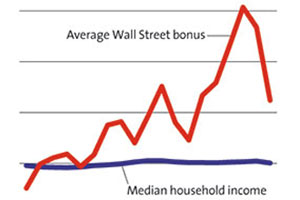
Flickr/<a href="http://www.flickr.com/photos/jtyerse/3954240271/">jtyerse</a>
The vast majority of the country is still slogging through these grim economic times, with 9.6 percent unemployment and anemic economic growth. Last week, claims for unemployment benefits unexpectedly jumped by 20,000, to 457,000, and the Labor Department is projected to announce a higher unemployment rate in its monthly jobs report tomorrow. But on Wall Street, in spite of diminished trading profits, one symbol of excess has fully bounced back: bonuses.
This year’s Wall Street bonuses, the New York Times‘ Susanne Craig reports, are expected to increase 5 percent; more specialized financiers could see bonuses rise by even 15 percent. This new data comes from a soon-to-be-released report by Alan Johnson, who studies finance compensation with Johnson Associates, a New York-based consulting firm. As Johnson told the Times, “I did not expect compensation would come back the way it has. I underestimated the industry’s resiliency.”
Craig rounds up some anecdotal evidence as well to illustrate how the heady, bonus-fueled days on Wall Street are back once again:
One does not have to look far to see that Wall Street has found its stride again. Hot new restaurants are opening, and they are packed with traders and investment bankers. John DeLucie, the chef and one of the owners of The Lion restaurant, one of Greenwich Village’s newest hot spots, said business had been surprisingly strong since it opened in May.
Customers are buying vintage bottles of wine; the restaurant recently sold a 1982 Château Mouton Rothschild for $3,950. “We are seeing a lot of luxury purchases, like vintage Bordeaux, things that we haven’t seen sell well in a few years,” Mr. DeLucie said.
Which sounds an awful lot like this 2004 Times story, “That Line at the Ferrari Dealer? It’s Bonus Season on Wall Street,” from when the housing mania was at its peak:
While the Maybach, an exclusive line of luxury cars made by Mercedes-Benz that starts at $315,000, appears on the wish lists of many bankers, relatively less expensive models from Aston Martin, Bentley, and Maserati have also been popular. Michael Parchment, general manager for Miller Motorcars, a luxury dealership in Greenwich, said demand had been soaring.
”It’s probably up 20 to 30 percent from the same time period last year,” he said. ”Unfortunately, production isn’t up.” The result, he said, are some unhappy bankers.
One more nugget for you, a number to keep in mind: Between Goldman Sachs, Morgan Stanley, Citigroup, Bank of America, and JPMorgan Chase, the amount of money set aside for bonus pay this year totals a staggering $90 billion. That’s actually down about 3 percent from last year, Craig notes—but by comparison, it’s also larger than the GDPs of 157 of the world’s countries.













